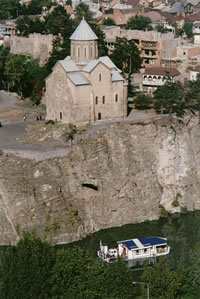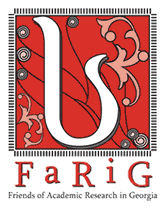Georgian Civilization
 For the past 3,000 years Georgia has had its own delightful and distinctive civilisation. With an inspiring and varied landscape, ranging from the Alpine to the sub-tropical, the country has nurtured artists, sculptors, musicians, architects and writers in every generation of its history. Because of its location on the ancient silk road and at the cross-roads of competing empires, Georgia has absorbed and transformed the traditions of many other lands, while producing a vibrant and unique culture of its own. The nation's literary tradition, ranging from epic poetry to modern drama, is among the world's finest; and the architecture of Georgia's great churches and cathedrals as well as its mountain-top churches, and their icons and frescoes, many dating from Georgia’s golden age in the 12th century, are among the supreme achievements of Christian art.
For the past 3,000 years Georgia has had its own delightful and distinctive civilisation. With an inspiring and varied landscape, ranging from the Alpine to the sub-tropical, the country has nurtured artists, sculptors, musicians, architects and writers in every generation of its history. Because of its location on the ancient silk road and at the cross-roads of competing empires, Georgia has absorbed and transformed the traditions of many other lands, while producing a vibrant and unique culture of its own. The nation's literary tradition, ranging from epic poetry to modern drama, is among the world's finest; and the architecture of Georgia's great churches and cathedrals as well as its mountain-top churches, and their icons and frescoes, many dating from Georgia’s golden age in the 12th century, are among the supreme achievements of Christian art.
Beleaguered
Within a few months of gaining independence from the Soviet Union in 1991, Georgia was transformed from one of the more prosperous countries in the region to one of the poorest.
In an atmosphere of violence and chaos, the old economic system disintegrated, and with it the administration and care of Georgia's cultural heritage. Many of the country's leading scholars were forced to emigrate, or else work for tiny salaries which can be as little as $85 (or £65) per year. Many of them have left academic work for good, or taken second jobs to eke out their wages.
However deep their commitment to Georgia and its civilisation, the nation's scholars face a desperate struggle to keep themselves and their families above the poverty line. As as result, the preservation and study of Georgia's priceless frescoes, icons and paintings have been badly neglected. In many places, the nation's heritage is literally crumbling away.
The hostilities between Georgia and Russia which broke out in August 2008 constituted another major setback. FaRiG has however pledged to continue its work.
FaRiG's Work
 FaRiG is a British charity which gives grants to Georgian scholars for their research and publishes the results in Britain. Here are examples of grants we have given:
FaRiG is a British charity which gives grants to Georgian scholars for their research and publishes the results in Britain. Here are examples of grants we have given:
- Icon painting changes style very slowly. But in about 1600 a complete change of style occurred, based on hitherto unknown foreign influences. Art history sets a large question-mark over what these influences may have been. FaRiG has given a grant to Dr Mzia Janjalia and Nana Kuprashvili to search for the answer. We aim to increase such grants.
- FaRiG has given a grant to Nr Nino Kebuladze of the S Janashia Museum of Georgia for the purchase of a digital microscope camera which she is using in her conservation, publications and teaching work for the Museum and the Anglo-Georgian Expedition to Nokalakevi.
Ready to help?
For the funds which individual and charities have entrusted to FaRiG we are extremely grateful. The latest large gift was from the Walter Guinness Charitable Trust. Grants have also been made by Rothschild Foundation and British Georgian Society.
Every four months, and at the end of the project, the scholars are required to give a detailed account of the expenditure of the grant. English charity regulations require FaRiG to provide a full annual account.
The few projects so far have cost FaRiG less than £18,000 but these relatively small amounts of money are received as a life-line by the Georgian scholars, who see the presentation of their culture as tantamount to the preservation of their own national survival.
As friends of Georgia we would like to encourage their work in preserving one of the threatened civilisations of the world.
